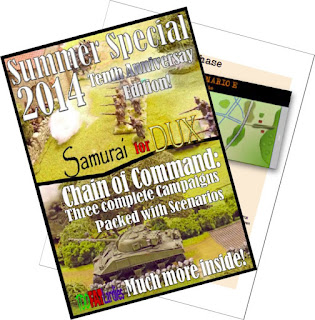My France 1940 project has taken inspiration from several sources. Today, I want to take a look at Chain of Command from Too Fat Lardies. These are an innovative set of platoon-level rules for World War 2. The core strength of any set of TFL rules is the depth of research that Rich and his team invest in each publication. The basic rules concentrate on the later WW2 period, but TFL offer some of the best resources in the business. The first is a supplement called At The Sharp End, which provides a framework within which a whole campaign can easily be created.
The other TFL resource is actually a series of resources. Twice a year, TFL publish specials that are packed with all sorts of interesting content. In particular, the Summer 2014 and the Summer 2015 Specials each include a potted campaign for France 1940, designed to be used with At the Sharp End.
The Summer 2014 edition includes a campaign called Strawberries for Elephants which follows the exploits of the 2nd Durham Light Infantry on the River Dyle that I mentioned in my last post. This time it is covered in more depth with 11 scenarios (more if the first battle is inconclusive). The Summer 2015 edition then looks at the retreat of the Welsh Guards towards Boulogne. Each of these campaigns provide background, force lists (although Chain of Command doesn't use a points system) and some brilliant maps.
I can't recommend TFL products highly enough. The rules allow the player to think about the problems with which a small-unit leader would have to contend, and are also of the right size - I can easily play these games of a 3' x 4' table.
Bye for now.
My current project isn't my first attempt to re-fight France 1940. Back when I was at school, I had a small selection of models in (sort of) HO Scale. I had an Airfix 25 pounder, Panzer IV and Bren Carrier, along with a Matchbox Matilda II and PAK 36 anti-tank gun, and not much else. In the days before disposable income and the internet, I had little information to go on. For rules, I remember having a choice between the Donald Featherstone books I could find at the library or a selection of WRG publications.
Moving forward about 30 years, I was afraid that wargaming resources would still be thin on the ground. It didn't take me long to realise that I would be spoilt for choice.
In the next two or three posts, I'll take a quick look at the resources that I have been using to plan my campaign. I don't plan to review these in any detail - there are people out there more eloquent and insightful than me who would do a better job. These are just the books and websites that I have found useful. Today I want to take a look at the Battlegroup rules and supplements from Ironfist Publishing.
Ironfist started publishing in 2012 with a book called Battlegroup Kursk. Focused on the Eastern Front in 1943, the book is a lavishly illustrated, hardback book which contains all of the rules, army lists and scenarios to recreate the battles around Kursk. Following this book, Ironfist took a slightly different approach and starting publishing supplements. They next focused on the later periods of the war with Overlord and Fall of the Reich. Each supplement provides the history, army lists and scenarios for each period, but in order to play any of these supplements you will need either the Kursk book or the smaller, rules-only book which is also available as a PDF.
I happen to like this approach. I am a sucker for books, and the book lover in me really likes these supplements. Publishing the rules separately allows more space for the specific content - artwork, photographs, maps and data - that will give each game the right flavour. And I must say, the quality of the army lists and research is top notch.
I was delighted when Ironfist published Battlegroup Blitzkrieg earlier this year. This book covers not just the fall of France but also the invasion of Poland in 1939, and is packed with some great stuff. It includes all of the equipment and forces that were involved (Belgian and Dutch armies included) and the example battles are presented beautifully - the maps in particular are great. One of the highlights is a scenario covering the 2nd Durham Light Infantry on the River Dyle, and in particular the award of the first Victoria Cross to the British Army during the war.
The publication of the rules as a separate book has actually helped me enormously as it has allowed me to learn the core rules more quickly, and only then dive into the detail of the period. I was very pleasantly surprised by how the Battlegroup rules work. They offer different scales of encounter, from squad/section level all the way up to battalion-sized actions. With a 3' x 4' table, I'm not going to recreate the entire retreat to Dunkirk, but the rules seem to work really well for a platoon-sized action.
Even for those not interested in the Battlegroup rules, I can thoroughly recommend Battlegroup Blitzkrieg as a sourcebook for any early WW2 campaign. The research appears very complete to me, and the artwork is stunning. The books in print and PDF format are available from The Plastic Soldier Company.
As inspiration, both of the photos in this article are of the stunning Battlegroup Blitzkrieg demonstration game at Salute 2015, taken by me. If I could only get my games to look this good...
Bye for now.




